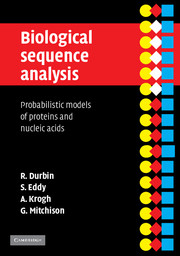Book contents
- Frontmatter
- Contents
- Preface
- 1 Introduction
- 2 Pairwise alignment
- 3 Markov chains and hidden Markov models
- 4 Pairwise alignment using HMMs
- 5 Profile HMMs for sequence families
- 6 Multiple sequence alignment methods
- 7 Building phylogenetic trees
- 8 Probabilistic approaches to phylogeny
- 9 Transformational grammars
- 10 RNA structure analysis
- 11 Background on probability
- Bibliography
- Author index
- Subject index
1 - Introduction
Published online by Cambridge University Press: 05 September 2012
- Frontmatter
- Contents
- Preface
- 1 Introduction
- 2 Pairwise alignment
- 3 Markov chains and hidden Markov models
- 4 Pairwise alignment using HMMs
- 5 Profile HMMs for sequence families
- 6 Multiple sequence alignment methods
- 7 Building phylogenetic trees
- 8 Probabilistic approaches to phylogeny
- 9 Transformational grammars
- 10 RNA structure analysis
- 11 Background on probability
- Bibliography
- Author index
- Subject index
Summary
Astronomy began when the Babylonians mapped the heavens. Our descendants will certainly not say that biology began with today's genome projects, but they may well recognise that a great acceleration in the accumulation of biological knowledge began in our era. To make sense of this knowledge is a challenge, and will require increased understanding of the biology of cells and organisms. But part of the challenge is simply to organise, classify and parse the immense richness of sequence data. This is more than an abstract task of string parsing, for behind the string of bases or amino acids is the whole complexity of molecular biology. This book is about methods which are in principle capable of capturing some of this complexity, by integrating diverse sources of biological information into clean, general, and tractable probabilistic models for sequence analysis.
Though this book is about computational biology, let us be clear about one thing from the start: the most reliable way to determine a biological molecule's structure or function is by direct experimentation. However, it is far easier to obtain the DNA sequence of the gene corresponding to an RNA or protein than it is to experimentally determine its function or its structure. This provides strong motivation for developing computational methods that can infer biological information from sequence alone. Computational methods have become especially important since the advent of genome projects. The Human Genome Project alone will give us the raw sequences of an estimated 70,000 to 100,000 human genes, only a small fraction of which have been studied experimentally.
- Type
- Chapter
- Information
- Biological Sequence AnalysisProbabilistic Models of Proteins and Nucleic Acids, pp. 1 - 11Publisher: Cambridge University PressPrint publication year: 1998

